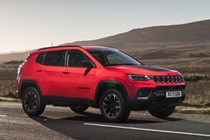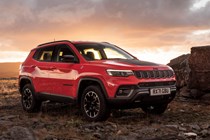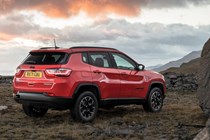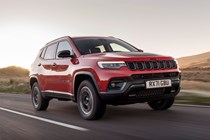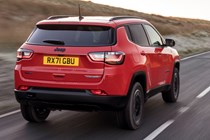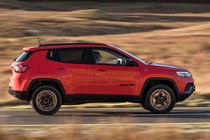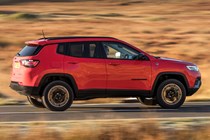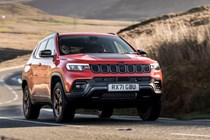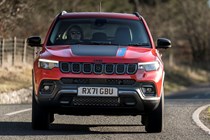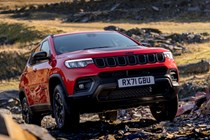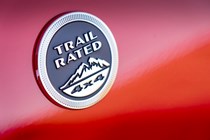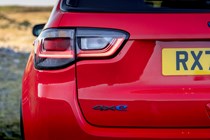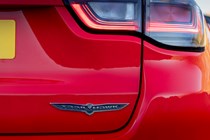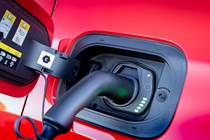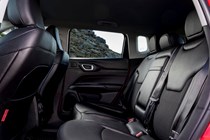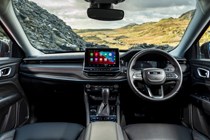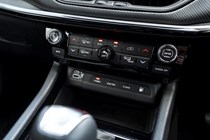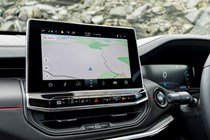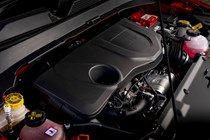Jeep Compass boot space, practicality and safety
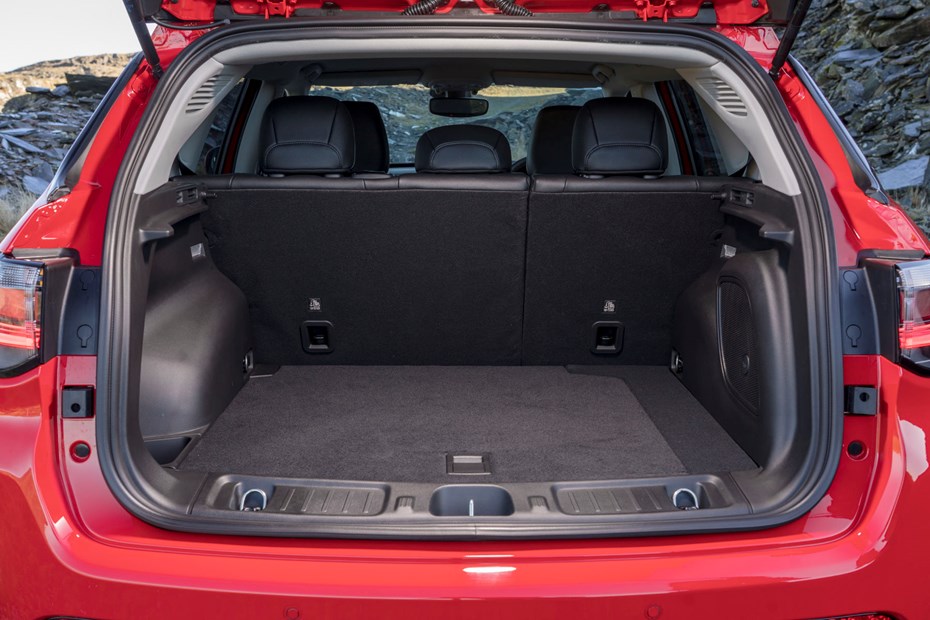
- Good passenger room
- Decent cubby holes
- Boot size unaffected by PHEV
Although the Compass isn’t much bigger on the outside than the Jeep Renegade, you really notice the difference in size inside.
Step inside and you’ll be relieved to find there’s enough room for two occupants to sit comfortably without bothering one another in the front.
The Compass is a five-seater with plenty of room throughout. Truth be told, three adults are likely to feel somewhat squeezed on the Jeep’s rear bench. But the same can be said for most cars in this sector.
Leg- and shoulder-room are decent enough, as is headroom. The optional panoramic roof doesn’t eat too much of the available space either.
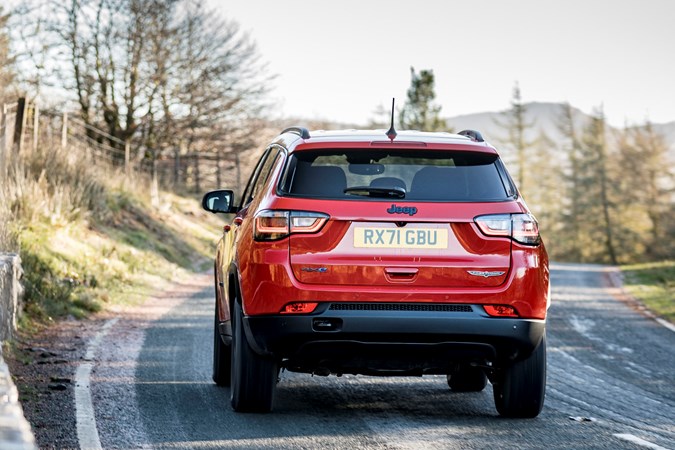
Boot space and storage
Jeep deems storage space an imperative for its customers. And it does excel. There’s somewhere to put your phone, deep bins big enough for bottles, and it’s upright infotainment system has room below it for things like keys.
Officially the boot will hold 438 litres, which makes it smaller than the Hyundai Tucson (620 litres), Peugeot 3008 (520 litres) and Nissan Qashqai (504 litres).
However, unlike with some hybrid and plug-in hybrid SUVs, the batteries and electrical components don’t make a difference to the boot size, as Jeep has hidden everything under the car’s floor. And the hybrids still get the same dual-function boot with a raised loading surface at the top and maximised loading capacity at the bottom.

Is it easy to park?
The Compass feels more compact than it actually is. So it’s unlikely to feel unwieldy to a buyer trading up from a more conventional hatchback.
Jeep has fitted the SUV with a reversing camera as standard (which helps improve visibility), while a self-parking system can be specified as an optional extra.
Safety
- Five star Euro NCAP
- Two isofix points
- Strong levels of safety kit as standard
The Jeep Compass achieved a five-star crash-test rating from safety organisation Euro NCAP.
Every Compass gets:
- Traction control
- Isofix lashing points for child seats
- Lane-departure warning
- Speed limiter
- Autonomous Emergency Braking
- Tyre pressure monitor
- Adaptive Cruise Control
- Blind spot monitor
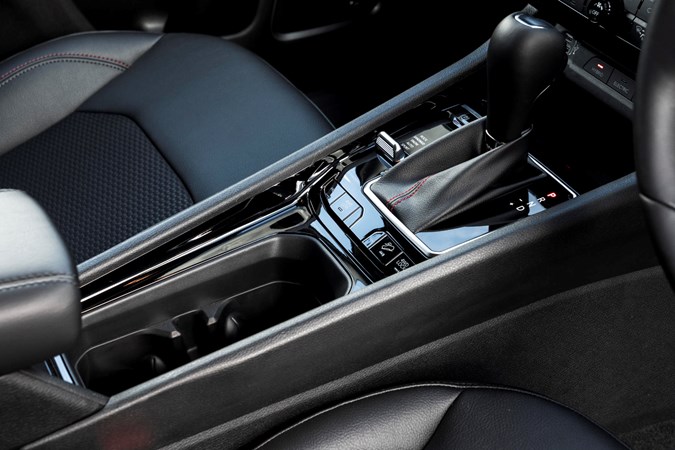
Euro NCAP rating
| What is Euro NCAP? ⓘ | |
|---|---|
| Adult Occupant: | 90% |
| Child Occupant: | 83% |
| Vulnerable Road User: | 64% |
| Safety Assist: | 59% |
Equipment and options
- 3x3 point rear seat belts
- Audio remote
- Driver`s airbag
- Heated mirrors
- Height adjustable drivers seat
- Isofix child seat anchor points
- PAS
- Passenger`s airbag
- Side airbags
- Steering wheel rake adjustment
- Steering wheel reach adjustment
- Traction control
- Air conditioning
- Alarm
- Cloth seat trim
- Heated seats
- n/a
- Air conditioning
- Alarm
- Cloth seat trim
- Heated seats
- Sat Nav
- n/a
- Air conditioning
- Alarm
- Cloth seat trim
- Heated seats
- ABS
- Body coloured bumpers
- CD
- Cruise control
- Electric driver`s seat
- Electric mirrors
- Electric passenger`s seat
- Electric sunroof
- Folding rear seats
- Front electric windows
- Front fog lights
- Leather seat trim
- Lumbar support
- Parking sensors
- Rear electric windows
- Roof rails
- Sat Nav
- Sports seats
- Telephone
- Heated seats
- ABS
- Air conditioning
- Alarm
- Body coloured bumpers
- CD
- Cloth seat trim
- Cruise control
- Electric driver`s seat
- Electric mirrors
- Electric passenger`s seat
- Electric sunroof
- Folding rear seats
- Front electric windows
- Front fog lights
- Leather seat trim
- Lumbar support
- Parking sensors
- Rear electric windows
- Roof rails
- Sat Nav
- Sports seats
- Telephone
- ABS
- Air conditioning
- Alarm
- Body coloured bumpers
- CD
- Cruise control
- Electric mirrors
- Front electric windows
- Front fog lights
- Lumbar support
- Rear electric windows
- Roof rails
- Sat Nav
- Telephone
- Cloth seat trim
- Electric driver`s seat
- Partial leather seat trim
- Air conditioning
- Alarm
- Cloth seat trim
- Heated seats
- ABS
- Body coloured bumpers
- CD
- Cruise control
- Electric driver`s seat
- Electric mirrors
- Front electric windows
- Front fog lights
- Lumbar support
- Metallic Paint
- Partial leather seat trim
- Rear electric windows
- Roof rails
- Sat Nav
- Sports seats
- Telephone
- Air conditioning
- Alarm
- Cloth seat trim
- Electric sunroof
- Heated seats
- Metallic Paint
- Parking sensors
- n/a
- Air conditioning
- Alarm
- Cloth seat trim
- Heated seats
- n/a
- ABS
- Air conditioning
- Alarm
- Body coloured bumpers
- CD
- Cruise control
- Electric driver`s seat
- Electric mirrors
- Electric passenger`s seat
- Folding rear seats
- Front electric windows
- Front fog lights
- Heated seats
- Leather seat trim
- Lumbar support
- Rear electric windows
- Roof rails
- Sat Nav
- Sports seats
- Telephone
- n/a
- Air conditioning
- Alarm
- Folding rear seats
- Heated seats
- Leather seat trim
- Lumbar support
- Sat Nav
- n/a
- ABS
- Air conditioning
- Alarm
- Body coloured bumpers
- Cloth seat trim
- Cruise control
- Electric mirrors
- Front electric windows
- Rear electric windows
- n/a
- Air conditioning
- Alarm
- Cloth seat trim
- Electric driver`s seat
- Electric passenger`s seat
- Heated seats
- Leather seat trim
- Lumbar support
- Metallic Paint
- Parking sensors
- n/a
- Air conditioning
- Alarm
- Electric driver`s seat
- Electric passenger`s seat
- Folding rear seats
- Heated seats
- Leather seat trim
- Lumbar support
- Parking sensors
- ABS
- Body coloured bumpers
- CD
- Cloth seat trim
- Cruise control
- Electric mirrors
- Front electric windows
- Front fog lights
- Full size spare wheel
- Rear electric windows
- Roof rails
- Sat Nav
- Space saver spare wheel
- Sports seats
- Telephone
Dimensions
| Length | 4394mm - 4404mm |
|---|---|
| Width | 2033mm |
| Height | 1624mm - 1659mm |


